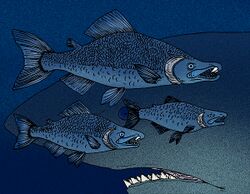Biology:Oncorhynchus rastrosus
| Oncorhynchus rastrosus | |
|---|---|

| |
| Scientific classification | |
| Domain: | Eukaryota |
| Kingdom: | Animalia |
| Phylum: | Chordata |
| Class: | Actinopterygii |
| Order: | Salmoniformes |
| Family: | Salmonidae |
| Genus: | Oncorhynchus |
| Species: | †O. rastrosus
|
| Binomial name | |
| †Oncorhynchus rastrosus (Cavender & Miller, 1972)
| |
| Synonyms | |
|
Smilodonichthys rastrosus | |
Oncorhynchus rastrosus (synonym Smilodonichthys rastrosus[2]) also known as the saber-toothed salmon,[3] or spike-toothed salmon[4] is an extinct species of salmon that lived along the Pacific coast of North America and Japan .[5] They first appeared in the late Miocene in California , then died out some time during the Early Pliocene.[1]
O. rastrosus was the largest member of the Pacific salmon genus Oncorhynchus, varying from 1.9 m (6 ft 3 in) and 177 kg (390 lb)[1] to 2.4 m (7 ft 10 in) and 200 kg (440 lb).[6][1]
Members of this species had a pair of small "fangs" protruding from the tip of the snout, thus explaining the common name and synonym. Adults of O. rastrosus had larger gill rakers compared to their smaller, modern relatives, leading scientists to suggest that the adults ate plankton. These salmon are believed to have been anadromous like their living relatives.[7]
Scientists once thought the teeth pointed straight down, like a saber-toothed cat's teeth. Now it is believed the teeth stuck out sideways from the mouth. According to paleontologist Julia Sankey, the salmon did not possess spike teeth throughout its life; the fish developed the teeth as it transitioned from life in the ocean to fresh water. The salmon bred in fresh water, as Pacific salmon do today. Tooth wear patterns suggest the salmon used its teeth to defend territory and mark nests during the breeding phase.[4]
References
- ↑ 1.0 1.1 1.2 1.3 Sankey, Julia; Biewer, Jacob; Basuga, Janis; Palacios, Francisco; Wagner, Hugh (2016). "The giant, spike-toothed salmon, Oncorhynchus rastrosus and the "Proto-Tuolumne River" (early Pliocene) of Central California.". PaleoBios 33: 1–16. https://escholarship.org/uc/item/84g0595b.
- ↑ Cavender, T., & Miller, R. R. (1972). Smilodonichthys rastrosus: A new Pliocene salmonid fish from Western United States. Museum of Natural History, University of Oregon.
- ↑ "Saber-toothed Salmon", The Museum of Natural and Cultural History (University of Oregon), http://natural-history.uoregon.edu/collections/web-galleries/saber-toothed-salmon, retrieved 2012-04-27
- ↑ 4.0 4.1 Black, Riley (November 25, 2016). "Paleo Profile: The Spike-Toothed Salmon". Scientific American. https://blogs.scientificamerican.com/laelaps/paleo-profile-the-spike-toothed-salmon/.
- ↑ Takakuwa, Yuji (2021). "The first fossil record of giant spike-toothed salmon, Oncorhynchus rastrosus from the Northwestern Pacific region". Bull.Gunma Mus.Natu.Hist. 25: 41-48. http://www.gmnh.pref.gunma.jp/wp-content/uploads/bulletin25_3.pdf.
- ↑ Stearley, R.F. and G.R. Smith. 2016. Salmonid fishes from Mio-Pliocene lake sediments in the Western Snake River Plain and the Great Basin. in W.L. Fink and N. Carpenter (eds.). Fishes of the Mio-Pliocene Western Snake River Plain and Vicinity. Misc. Pub. Museum Zoology, University of Michigan 204:1–45
- ↑ Thomas P. Eiting, Gerald R. Smith, Miocene salmon (Oncorhynchus) from Western North America: Gill Raker evolution correlated with plankton productivity in the Eastern Pacific, Palaeogeography, Palaeoclimatology, Palaeoecology, Volume 249, Issues 3–4, 19 June 2007, Pages 412-424, ISSN 0031-0182
Wikidata ☰ Q13416772 entry
 |

